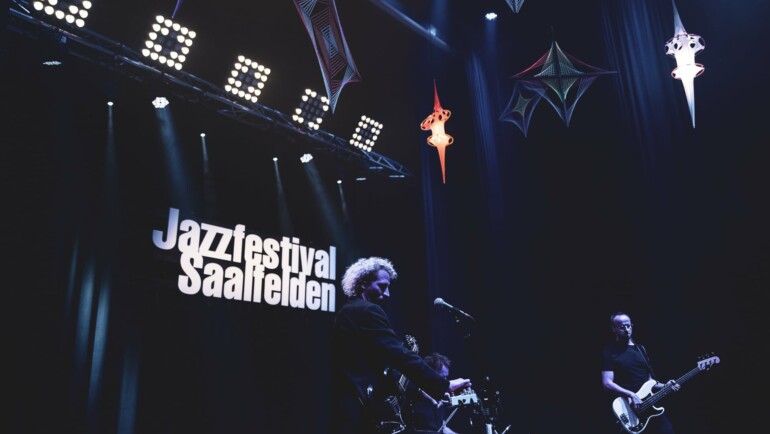
INTERNATIONAL JAZZ FESTIVAL SAALFELDEN took place once again, for its 41st time at the end of August 2021. It was, as usual, a strong, long and explosive program. Therefore packing it into a collection of words won’t do it justice, however, there were some threads to follow and describe, which weaved in and out of the program this year.

Jazz Fest Saalfelden – a national treasure, an international legend. The figures, the history and the stories behind the festival are complex and extraordinary. (It just takes going there, oneself, to hear them from one or the other local, fanatic or frequent visitor.) There’s a feeling of family there, but, on an international scale. How does a festival in a tiny Austrian town achieve such a task? What’s the draw? The phenomenal alpine landscape? The good air? The welcoming and enthused community? The incredible backline, festival team and programming? Their openness to change, adaptation and growth? Surely, it’s a combination of all of these things. And although each year is special in its own way, there was something in the air this year. It’s hard to put one’s finger on it, with a program as diverse and expansive as it thankfully was. But a few emotional and thematic threads running through the festival this year could be traced. So, let’s trace them…

INVENTION
An undeniably potent part of the festival’s 41st edition was improvisation. With a notably heavy focus on, and leaning into the realm of the unknown, the stages hosted fewer compositions and more ideas; less rehearsal, more trust; less stasis, more breakthrough.
Setting the tone was the Artist in Residence, vocal and verbal artist, Christian Reiner, who made no secret about the fact that every single one of his projects would be improvised, premiere events, stepping deep into unknown waters at every port he landed with each ship he sailed. From his project “Luft”, engaging 5 wind instruments, to the live cinematic improvised children’s program TeTeTe/Bienenkinoto to his collaboration with a bookbinder, to name a few, Reiner pushed boundaries and performed detailed experiments each step of his unique way. The result of his residency was a dynamic and powerful collection of improvisational and conceptual art, and investigative experiments.

Not only improvisation, but its close relative, courage, profoundly penetrated this year’s program. Stepping out of comfort zones and showing new and lesser-known sides, seemed a common approach across stages and formations. A prime example was the trio, /kry (Mona Matbou Riahi – clarinet/fx, Philipp Kienberger – bass, Alexander Yannilos – drums). The fresh (about as old as the pandemic) formation surprised the audience with explosive expression and bold concepts, seemingly pushing the musicians and their music to their edges.

The powerful sound bounced back and forth, seamlessly, between frenzied free jazz fragments and broad, unified, thrashing beats, sending vibrations through the audience, as well as the physical space it was held in. And what a space it was…
A structural invention of this year’s festival was a brand new venue, and, arguably the best yet, of all the location roll-outs over the last few years (city park, bookbindery, court hall, bookstore, jazz mountain hikes and huts, etc.). This year’s prize addition was the Otto-Gruber Hall, a large-scale machinery storage warehouse, smack in the center of the town, mere steps away from the main venues. The luck of its location aside, the space itself is tremendous. An industrial paradise. And a haven for a certain brand of musicianship – the raw kind. The type that organically marries roughness with beauty.

So, what better act to christen the space than a trio of boundary-pushing, improvisational masters – internationally-renowned, improvisational poet and musician, Moor Mother, together with experimental powerhouse drummer Lukas König, and distinctively compelling bassist/percussionist, Shahzad Ismaily? This opening performance of the Otto-Gruber-Hall turned out to be one of the most unexpected highlights of the festival – not because anyone doubted their abilities, but just because no one knew what to expect. They literally had never played together before. Not a rehearsal, nor even a sound check was possible for this newborn trio, as Ismaily, enduring countless travel complications due to the pandemic, jumped straight out of his airport shuttle onto the stage, exactly two minutes to show time.
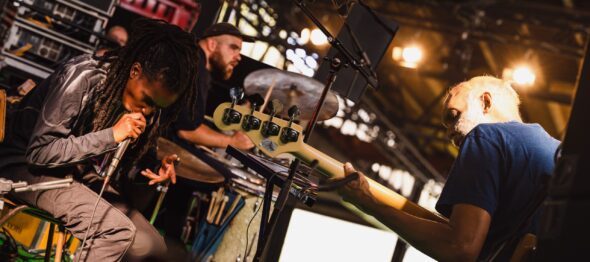
Regardless of the challenging circumstances, what resulted was nothing less than astounding. The trio tore up the stage and mind-wiped the audience. With intense musical connection, driven by experimental prodigies, three became one, in an explosive performance of heavy industrial beats mixed with complex rhythms, dynamic changes, powerful poetry, soul-burrowing bass elements and playful percussion, prancing upon it all like fairy dust. The three drove, pushed, challenged and completed one another. The joy of it all was palpable on stage, and bled generously out into the audience, which, by the end, was raised to their feet and seduced to the foot of the stage (a genuine feat at a jazz festival).
Another scene of invention arrived via artist, Katharina Ernst, who went far beyond conventional concert parameters by creating a performance space, which she herself painted in the days leading up to the show. The large-scale mural in the “Kunsthaus” at the lower level of the Nexus venue, was an expansive cloud-scape, which, when placed in front of, turned Ernst into a kind of percussive angel sitting in the heavens of conceptual experimental composition. The brightly-lit clarity of the scene, in combination with the clarity of her current musical concept, was quite extraordinary. This elaborate design accompanied the release of her new EP, “le temps”, her latest solo project, which marks a stark contrast to her previous work. Stripping away any electronic elements, the artist demonstrated the microscopic subtleties and potentials of her chosen instruments. As the title indicates, the project is something of a study on time, as well as a musical investigation about the single parts of a drum set and other percussive elements. Pairing this with the backdrop of her visual art, the multifaceted artist put her multiple talents and passions on display, directly and in unity, for the first time.
A highlight among the Shortcuts series was the premiere of the trio, Taborn/Lillinger/Stemeseder. Pianist, Elias Stemeseder took the role of the middleman, making counterpoints with low frequencies and highly unusual sounds – almost like a producer – over which Lillinger (drums) and Taborn (keyboards) soared, with their powerful free jazz approaches. In waves, however, throughout, the three locked steps with minimal gestures intertwined with complicated rhythmic structures, which, nevertheless, had the audience in motion along with it. All in all, the concert offered an enjoyable mix of electronic structures and acoustic sound-art. Improvisation in harmony among extremely capable musicians.

The festival was equally blessed with a presentation of the latest work of Rdeča Raketa, the duo of musicians and composers, Maja Osojnik and Matija Schellander, entitled “… and cannot reach the silence”. Like Ernst, they utilized the space downstairs in the Kunsthaus Nexus to present their multimedia art, by projecting videos from their collaborators, Patrick K.-H. and Ivan Marusic Klif.

In doing so, the sounds – a mixture of fragmented, heavy and industrial beats and noises – became one with the strange visual world of high contrast scenes made up of dancing black and white figures in stop-motion, body parts multiplying themselves and eyes staring and blinking at you. Maja’s voice, of sung and spoken words, cut straight through all the noise and chaos. Mournful statements such as, “your love doesn’t love me” or “she was born already broken” echoed through the hall. As a finale, the whole room turned red and the noise suddenly quieted. Maja’s lyrics wandered into other realms of darkness. “My breasts don’t feed me, nor you…” David Lynch might have enjoyed this show. Or been a secret co-producer.
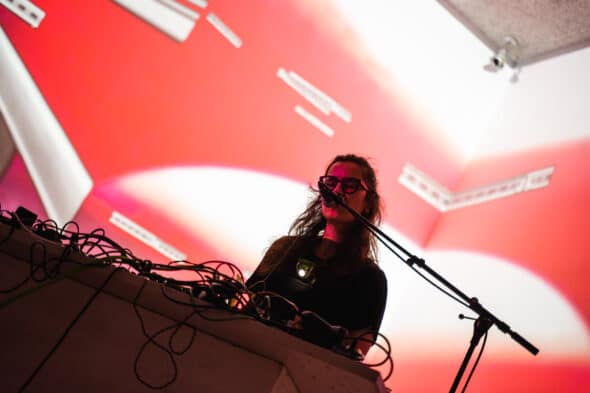
RAW
Ceramic Dog (Marc Ribot – guitars, vocals, E-flat horn; Shahzad Ismaily – bass, keyboards, backing vocals; Ches Smith – drums, percussion, electronics, backing vocals) is well known for its rawness, even if they are playing pre-composed, often-played songs. The scrappiness of the three powerhouse musicians, carried by Marc Ribot’s on-point lyrics and political messages, hits the spot on all kinds of taste buds. There’s a who-gives-a-f*ck energy which is deeply refreshing in times like these. (In all times, really.) Watching Marc’s scrappy, taped-up, comically long sheet music, dangling from the stand, was also a highlight for lovers of detail. When asked about how old they must be, from the looks of them, he replied, “Not that old. I just spill a lot of stuff on them.” Sigh, who doesn’t love Marc Ribot?

Notable, as well, was Smith’s additional percussive elements, in addition to his usual kit, which he banged and thrashed as always, in his signature hardcore rock jazz drummer approach, swinging madly at the cymbals placed excessively high above him. Interesting, as well, was the massive gong in Ismaily’s corner which, at one point, Smith strutted over to, to begin banging at himself; quite close to Ismaily’s ear, at that. When asked about this, Ismaily shrugged and said, “It was not a problem. I just turned my bass amp up.” Now, that’s rock and roll, isn’t it? Altogether, the show was loud, powerful and enlivening, though, the soft, jazz-infused portions sprinkled in between, did not go unnoticed. Maybe it indicated a time for quiet reflection? Amidst all of that political rage?

Fünf brought together Christian Reiner (voice), Jim Black (drums), Philip Zoubek (piano, fender rhodes) Martin Siewert (guitar) and Christian Weber for an all-star set of raw, high-volume, high-energy, free jazz improvisation, infused with rock. The players had never performed in that formation before. But, given the talent and experience behind it, it just worked. Immediately. Siewert, with his harsh, noisy slides, Reiner with his screams and growls, seemingly scraping at the bottom of his pelvic floor and throat all at once, Zoubek spastically playing the piano – it was stress and it was rough, but in a good way. Quiet melodic moments intermingled as well. Serene, but still, enveloped in darkness.

The quartet, Vegeta (Martin Zrost – saxophone, Helge Hinteregger – throat, Lukas Kranzelbinder – bass and Lukas König – drums) had their second concert after eleven years at Saalfelden this year. (No, that wasn’t a typo. Ten years + one is how long it took for the band to reunite.) Given the excessive pause, was everyone nervous? If so, no one could tell. It was a killer show, with fervour, power and a lot of spirit.
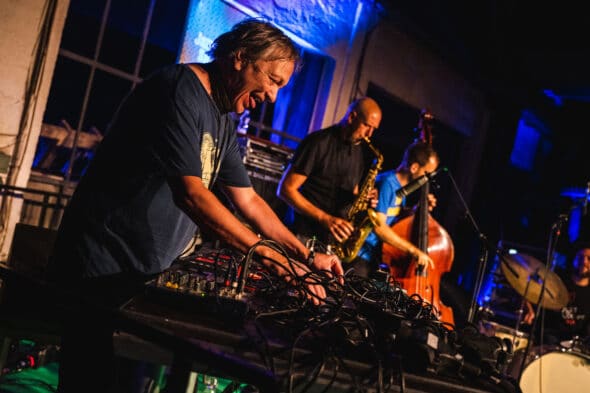
The sax and throat combination created scratchy drone-like spaces, propelled by feverish bass playing and never-predictable, ever-driving drums. It was a show to keep one on their toes, and scratch their head about just how Hinteregger could produce such guttural, buzzing sounds, like a male bee in a violent mating competition with another male candidate. Mating games aside, the show was riveting, and we all hope we won’t have to wait another decade for the next one.
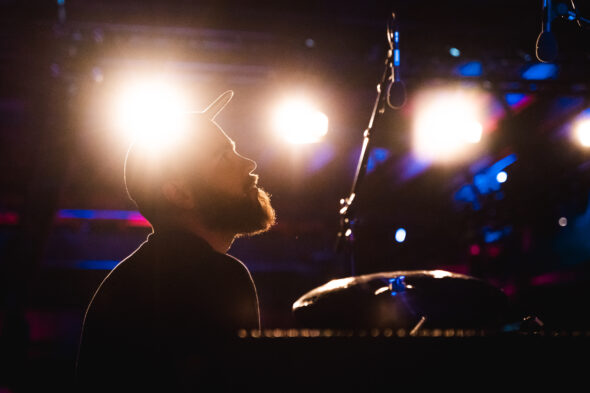
PLAY

Dell/Lillinger/Westergaard (Christopher Dell – vibraphone, Christian Lillinger – drums and Jonas Westergaard – double bass) is a trio known for its virtuosity and experience. But is it known for its incredible playfulness? It should be. In their notably close stage positions, they intensely swung, swayed and vibrated together, in a paradoxically frenzied unison. Like an atom with electrons firing around the nucleus which was their music. The twinkling of Lillinger’s signature speedy and
uniquely gentle drumming, the pats and twangs of the bass and the spastic, pounding of the vibraphone – it was a sound to be heard and a sight to be seen. The music brought with it, associations to the sounds of retro video games – Pinball, Pac Man, Donkey Kong. To say it was intense is an understatement. Gentle aggression, light and furious. Nothing less than Tinkerbell on speed.
GeoGeMa (Gerald Preinfalk – reeds, Georg Vogel – microtonal keys, Matheus Jardim – drums) was another highlight. Three remarkable players, with very different approaches and musical backgrounds, coming together as one. The bonds between them, as well as the respect, was palpable. They left each other plenty of space to show off their skills, their tastes, their musical identities, but then joined together again, building up into one eruption of melodies on speed, broad powerful movements and energizing beats. Speaking with Jardim, he explained that the relationship between him and his two bandmates only grows as time goes on. Playing with Georg Vogel, he says, he has learned and changed so much, “even though Georg hasn’t changed”. Being in his and Preinfalk’s musical presence, has been a gift, from which the three have mutually benefited and developed together significantly. This was not surprising to hear after watching the stellar show they produced.

The young band, chuffDRONE showed off their skills on the main stage on the last evening of the festival. Skipping to and fro between jazz segments of complex composition, interlaced with improvisation; then out of nowhere diving straight into super tight groove riffs, the audience was properly kept on their toes (and forced out of step in their dance moves). Communication and playfulness seem to be keys to the success of this young Viennese group, made up of Lisa Hofmaninger – saxophone, bass clarinet, Robert Schröck – saxophones, clarinet, Jul Dillier – piano, Judith Ferstl – bass, and Judith Schwarz – drums.

LEGENDS
What’s an Austrian jazz festival without guitarist, Karl Ritter? That’s a question hardly worth answering, and was luckily unnecessary, at Saalfelden this year. Him and the band, KOMBOjaner, with Andrej Prozorov on saxophone, Erich Buchebner on bass, Philipp Nykrin on the keyboard and Herbert Pirker on drums, rocked the city park with soul-satisfying, out-there, experimental, hardcore music. The sound was all over the place, from funk to jazz, rock, groove, composition and improvisation. Ritter’s performance was a sight, with his guitars leaning off the side of him onto the floor, which he nonchalantly scratched at and slid over in tic-like spouts. Prozorov showed his versatility, with moments of airy repetition mixed with long form notes, like temporary screams from under water, then bouncing over to sounds that mimicked 90’s techno, to then heading towards husky blows full of raspy air. The heavy bass and on-point drums, held it all together. A rock concert in a park in the sun. But not without its shadows.

In his trio performance, Craig Taborn (piano) cultivated a high quality, notably diverse performance. With Ches Smith, not only being one of the most relaxed drummers of the jazz avant-garde, but also exhibiting great sensitivity, if not empathy, Taborn won a perfect player to compliment his ideas. Beautifully composed themes that Tomeka Reid (cello) played together were balanced by Smith’s lackadaisical, yet brutal touches.

One of the undeniable it-boys of the German jazz scene is Christian Lillinger. At this festival, one could see him play, every day, sometimes multiple times. And, as usual, he was on fire. He is generally known for his fairy dust approach to gently tickling the drums, especially cymbals, at an impressive velocity.

However, one particular show took this young legend out of the box he is most known for, and got him into the role of a loud, smashing, rock drummer. That context is KUU!, a phenomenal quartet made up of Jelena Kuljic (vocals), Lillinger (drums), Frank Möbius (guitar) and Kalle Kalima (guitar).

KUU! brings to music the rebel teenager mentality of the 90’s, including elaborate guitar solos, reminiscent of Guns N Roses, Prince or Queen. Whatever the homage, the band takes the audience out of the current time and place, bringing it back. Or forward. It’s hard to tell. Whatever it is, it takes you out, up and away. Besides the excellence work on the instruments, the lead singer seals the deal with her enormous versatility – reminding one of Janis Joplin in one moment, Joni Mitchell in the next, then hopping over to punk grunge and seemingly channeling the Beastie Boys in another, and then suddenly bringing in experimental vocals like a monkey in heat. She is all over the place, in the best sense of the phrase. KUU! tries everything out and succeeds.

The Avram Fefer Quartet closed the festival on Sunday night on the main stage. A foursome composed of legends, with Fefer leading the pack on saxophone, Marc Ribot on guitar, Nick Dunston on bass and Chad Taylor on drums, they had solid grounds to stand on. Born in San Francisco, living in various parts of Western Europe and landing in New York about 20 years ago, Fefer carries many a narrative and influence into his compositions, including his current project “Testament,” which was filled out especially well by the legendary musicians he chose for the task.

RAGE
At another premiere concert, Christian Reiner presented a new program from his trio LAVANT with Susanna Gartmayer (sax) and Katharina Ernst (drums), based on (as always) musical improvisation and (specific to this project) the poetry of Christine Lavant, for which he decidedly chose against his usual approach to poetry (as neutral as possible) and went for a shouting and fuming version instead, with the aim to better express the lamenting that Lavant infused in her texts.

The concert took place, not on a stage, but on uneven grass in a forest on a mountain. (Very Saalfelden.) One might have expected the serenity of the landscape to ruin the aggression-laden concept. However, somehow Reiner was able to dig into his inner depths and summon enough rage to meet his objective. The result was ironic perfection. Rage in beauty. Beauty in rage.

Irreversible entanglements, Camae Ayewa’s (aka Moor Mother) five-piece band, spontaneously extended to six at this Saalfelden appearance. When news arrived that drummer, Tcheser Holmes could not attend, Lukas König and Shahzad Ismaily were invited to the stage in his place. What unfolded was a vigorous, high-energy performance, with essentially no space to breathe – which normally could be a bad thing, however, among this level of musicianship, one had to question why anyone needs air anyway? The newly re-arranged band entered, and immediately sprang into musical fury.

Scene 2: enter Camae Ayewa, carrying a bell, bringing with her, spiritual percussion patterns spreading hesitantly throughout the collective. The conjured spirits seem awakened. Energy was drawn in great arcs. The sax player (Keir Neuringer) was forced to his knees, arrested in circular breathing, seemingly screaming to the sky. Ayewa’s shouts, cries and straight-to-the-bleeding-heart choice of words, hit the collective stream of consciousness directly. The whole thing ended with roars of “we had enough!” Of what? Of injustice? Oppression? Violence? Abuse? As usual with her poignantly minimal, yet relatable verbal art, one must come to their own ideas and associations. A circling back to oneself. Entangled, irreversibly.

TENDER
Reiner Weber is a duo spanning two decades. One doesn’t see the years in their faces, postures, nor in the freshness of their music, but in their seemingly effortless and organically sensitive communication. The connection and appreciation shown between these two is immediately apparent in their performing. Their art flows mutually and reciprocally, catching each other’s impulses, ideas, spouts of energy and moments of drawl. As Christian Reiner intimated, he feels safer with Weber than practically any other musician in the world. “He catches every tone. I have the feeling that no matter what I do, when he plays with me, it’s right. I can’t be wrong, because he makes it right,” he explained. Their duo performance at the Fuchs Bookbindery proved this to be true.
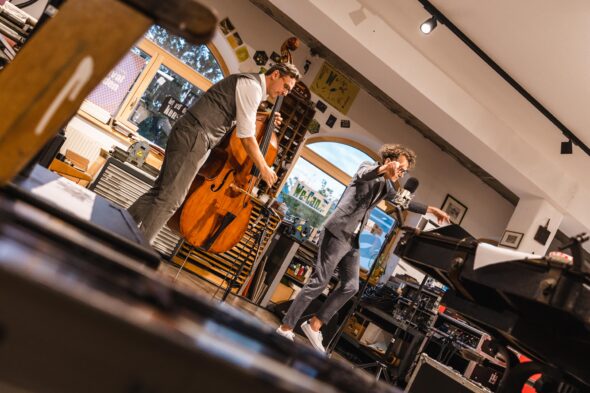
Clemens Wenger’s current solo album entitled “Physics of Beauty” brought him together with designer Alessia Scuderi and coder Gianluca Monaco from Sicily. The project exists as a synesthetic-audiovisual experience, and a music album as a digital artwork. The uncommon configuration came together for their first live show at the festival. In the quiet, windowless space of the Kunsthaus Nexus, Wenger interpreted his music on the pianino, while Scuderi and Monaco improvised with interactive visualisations to the music.

The result was a sensitively gentle musical-visual artistic performance. Fluttering notes and muffled beats, mirrored by the equally tender animated images dancing above them – at one moment the flat and sharp keys seemingly floating away into mid-air, as though someone snapped the string of a piano (as if there was one) and all of its parts drifted into a weightless atmosphere in the outer universe.

COMMUNITY
Elektro Guzzi (Bernhard Hammer – guitar, Jakob Schneidewind – bass, Bernhard Breuer – drums) made a stop at Saalfelden with their current program “Trip”, drawing a packed audience and turning the festival, for a brief moment, into a full-on techno-clubbing scene. Bopping bodies, banging heads, smiling eyes (above the masks) – a moment of release after another tense and tough year. The feeling of freedom and togetherness was tangible, delicious and needed.
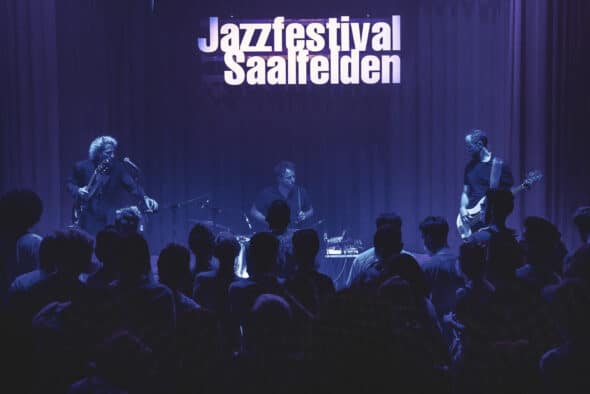
Furthermore, the feeling of community was present throughout the festival at large. It can’t be overstated – 41 years is a long time for a European jazz festival. It has gone through the phases of birth and infancy, all the way up to its current stage of adulthood. But instead of falling into the notorious mid-life crisis, it seems only to grow, expand, adapt and flourish. While some cultural events tend to stagnate, Saalfelden continues to amaze and surprise.

Moreover, even though the program has a strong focus on free jazz and experimental music – not exactly mainstream – rather than isolate and exclude itself from the place it exists, Jazz Festival Saalfelden has done the opposite. With its extensive offering of free concerts, its outdoor events in public spaces, its ongoing experimentation with various ready-made venues (bookbindery, church, bookshop, court offices, machinery storage space, and even collective hikes to concerts on mountain tops), and collaboration with the town and its inhabitants, it continues to grow together with the community, rather than apart. Its strategies of outreach, engagement and local innovation have brought about a sense of warmth and excitement by all the locals and visitors, alike; co-existing for one very special week in the year, which seemingly all sides genuinely look forward to and revel in. Going back to the original question of what makes this festival so special – maybe “community” is the the most subtle, yet most significant factor of all.

An anecdote to end: On one of my days in Saalfelden, I visited a local hairdresser. We shared many a word about the festival. We went through the printed program together, marking down all of the shows we both wanted to see. We exchanged opinions and experiences, as well as our gratitude for the festival overall. A far cry from the beginnings, four decades ago when, as she explained, other sentiments towards the festival existed and, for example, some local owners of restaurants would hang signs on their doors: “No Jazz Musicians Allowed!”
We’ve come a long way since then.
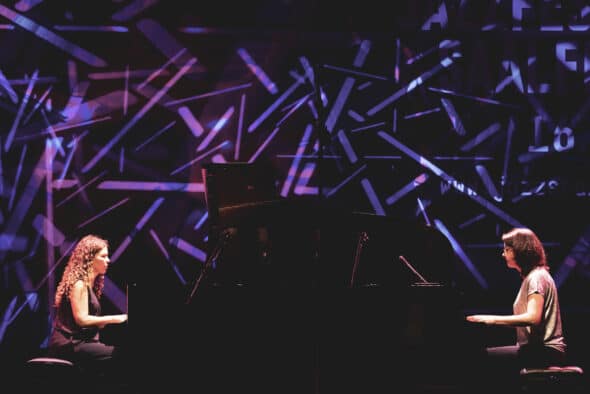
Arianna Fleur
Links:

